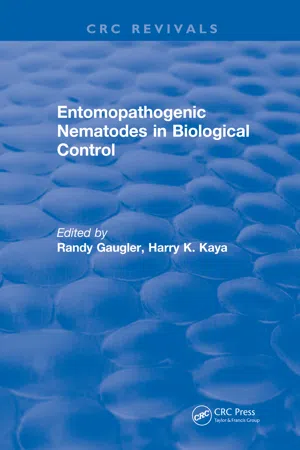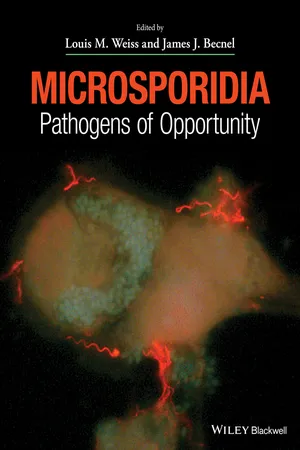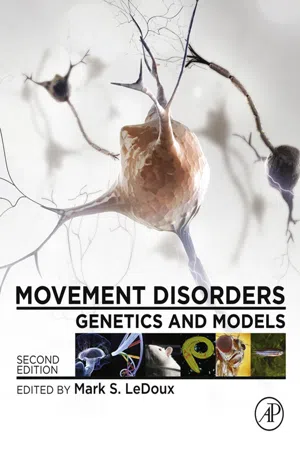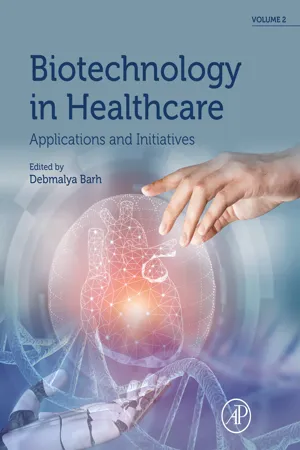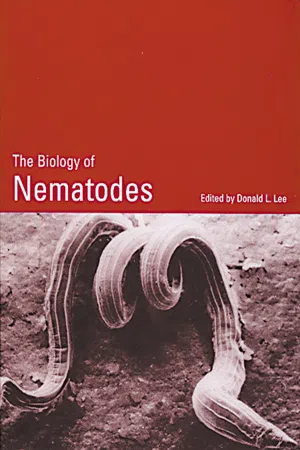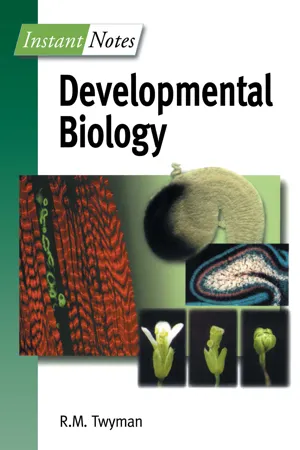Biological Sciences
C Elegans Life Cycle
The C. elegans life cycle is a well-studied model in biological research. It begins as an egg, hatches into a larva, and goes through four larval stages before reaching adulthood. The adult worm then reproduces, with the hermaphroditic individuals capable of self-fertilization, completing the life cycle.
Written by Perlego with AI-assistance
Related key terms
Related key terms
1 of 4
Related key terms
1 of 3
6 Key excerpts on "C Elegans Life Cycle"
- eBook - ePub
- Randy Gaugler(Author)
- 2018(Publication Date)
- CRC Press(Publisher)
C. elegans.The unique feature of Brenner’s concepts in C. elegans research is that almost all complex phenomena (e.g., timing of cell lineages, dauer formation and recovery, aging, behavior, and drug resistance) have been described in genetic and molecular terms. More than 75% of the nematode genome has been physically mapped and is kept in DNA libraries; the whole cell lineage chart has been reconstructed and described at phenological and genetic levels.3We do not intend to review recent C. elegans research. Our aim is rather to discuss this research from the aspect of its potential for studying entomopathogenic nematodes. We have focused on some selected features of C. elegans genetics and developmental biology (with special emphasis on dauer formation and recovery), and on a few aspects of the molecular biology and gene manipulations which, we believe, might be adopted for use in research on entomopathogenic nematodes. When comparing the genetics of C. elegans , Steinernema spp., and Heterorhabditis spp., we must realize how much is known about C. elegans and how little about entomopathogenic nematodes.II Comparison of the Developmental Biology of Free-Living and Entomopathogenic Rhabditida
A Alternative Life Cycles
1 Embryonic and Postembryonic Development
The life cycles of the Rhabditida (including Caenorhabditis, Heterorhabditis, and Steinernema genera) are similar. Embryonic development lasts about 1 hr and can be separated into a cell proliferation and a morphogenetic (cell migrating) stage. Hatching is followed by various juvenile stages (J1 -J4 ) preceding the adult stage. Each developmental stage is followed by a short quiescent state (called lethargus) and molt. The lengths of the different developmental stages are temperature dependent. In C. elegans, at 25°C, the average lengths of the different developmental stages are as follows: J1 , 11.5 hr; J2 , 7 hr; J3 , 7.5 hr; and J4 , 11.5 hr. At 25°C, a hermaphrodite produces about 320 self-fertilized eggs over 4 days. However, if permanently mated by males, the hermaphrodite may produce over a thousand cross-fertilized eggs during 5-6 days.7 The life span extends up to 3 weeks. C. elegans growth and reproduction occurs between 15 and 25°C, whereas C. briggsae and C. remanei - eBook - ePub
Microsporidia
Pathogens of Opportunity
- Louis M. Weiss, James J. Becnel(Authors)
- 2014(Publication Date)
- Wiley-Blackwell(Publisher)
C. ELEGANS, A MODEL ORGANISM FOR GENETIC AND CELL BIOLOGICAL STUDIES13.3.1 C. elegans Features and Available Tools
As described in the aforementioned text, microsporidian infections have been found in a variety of nematodes, including the free-living nematode C. elegans, which is often used for molecular and genetics studies and is arguably the best-studied nematode. Sydney Brenner chose C. elegans as a model genetic system because it has several advantages for studying biological questions (Brenner 1974; Girard et al. 2007). C. elegans can be easily cultured under laboratory conditions, is convenient for genetic analysis, and has a transparent, defined body plan (Fig. 13.3 a). In addition, strains can be frozen indefinitely and revived when needed (Stiernagle 2006). The power of C. elegans for discovery-based research is exemplified by the fact that findings from this system have been the basis for several Nobel Prizes in recent years (Marx 2002; Zamore 2006; Zimmer 2009).A cross-sectional schematic of C. elegans body plan and N. parisii life cycle inside the C. elegans intestinal epithelial cells. (a) C. elegans has a simple, nonsegmented body plan. Its alimentary system is composed of a pharynx that is used to pump in and grind up microbes, and the intestine composed of 20 epithelial cells that form a tube with a central lumen. C. elegans hermaphrodite reproductive system, with two gonad arms, the spermatheca and the vulva, is shown. The hypodermis (together with the cuticle, muscle, neurons, and excretory system (not shown)) makes up the body wall, which surrounds the internal organs. (b) Simple schematic diagram of the life cycle of N. parisii. To infect, N. parisii likely injects its sporoplasm via an everted polar tube into C. elegans intestinal cells. Once inside host cells, N. parisiiFigure 13.3 - eBook - ePub
Movement Disorders
Genetics and Models
- Mark S. LeDoux(Author)
- 2014(Publication Date)
- Academic Press(Publisher)
Caenorhabditis elegans , toward the investigation of evolutionarily conserved functional relationships among organisms represents a rapid route toward a comprehensive understanding of cellular malfunction.6.1. Caenorhabditis elegans : Why the Worm?
Starting in the early 1960s, Sydney Brenner championed the establishment of the nematode C. elegans as a model system for the investigation of embryonic and neuronal development (Wood, 1988 ). Brenner’s vision was centered on the premise that the simplicity of C. elegans anatomy and genetics, coupled with an ease of culturing, manipulation, and rapid generation time (3 days from fertilized egg to adult), would render it experimentally accessible for discerning more-complex issues of development (Brenner, 1974 ). Notably, although males can result from rare chromosomal nondisjunction events, C. elegans is primarily found as a hermaphrodite. The ability of this animal to self-fertilize is especially advantageous for purposes of laboratory propagation and in designing genetic crosses. Literally hundreds of isogenic animals can be obtained from a single worm in the course of several days, making expansion of stocks simple. Moreover, these microscopic worms (∼1 mm as an adult) can be stored frozen, much like bacterial and yeast cultures, and revived to replenish stocks even after several years in storage.In late 1998, C. elegans ushered in the genomic era for metazoan species, as it became the first animal to have its complete genome sequence released (The C. elegans Sequencing Consortium, 1998). This milestone enabled rapid and comprehensive molecular analyses to be coupled to powerful traditional genetic resources within the context of a multicellular organism. These collectively augment existing and unique resources for this animal, such as a defined neuronal connectivity and fully mapped cell lineage (Bargmann, 1998 - eBook - ePub
Biotechnology in Healthcare, Volume 2
Applications and Initiatives
- Debmalya Barh(Author)
- 2022(Publication Date)
- Academic Press(Publisher)
Drosophila research has advanced our understanding of numerous human diseases' cellular and molecular mechanisms and how they are useful for translation research.2. Caenorhabditis elegans models for translational research
Before diving into the translation significance of research performed using C. elegans, it will be good to know about the organism. C. elegans is a nonparasitic, transparent nematode worm whose life cycle starts with an egg, goes through several larval stages, and is finally an adult. It has an overall lifespan of 2–3weeks. An adult C. elegans has nearly 1000 somatic cells and is about 1mm in length. Although the size of this animal is small, it possesses many complex organ systems, such as the digestive system, nervous system, reproductive system, and muscular system. C. elegans exist in two sexes: a hermaphrodite and a male. A hermaphrodite worm can produce many progenies, while in the presence of a male, cross-fertilization happens. In the laboratory, C. elegans can be easily cultivated in large numbers on agar plates supplemented with the nonpathogenic bacterium Escherichia coli (Lewis and Fleming, 1995 ). In cases of food scarcity, the worm enters a “dauer” stage and can be maintained as such for months as a frozen stock at − 80°C (Apfeld and Alper, 2018 ).Ever since the 1970s, when Sydney Brenner pioneered the use of C. elegans for development and neurobiology research, C. elegans has been used to study human biology (Ellis and Horvitz, 1986 ). Brenner shared the 2002 Nobel Prize in Physiology or Medicine with H. Robert Horvitz and John Sulston for decoding the genetics of programmed cell death and animal development, including nervous system formation (Marx, 2002 ). Since Brenner's initial experiments, research performed with C. elegans has advanced our knowledge about many human pathologies such as aging, cancer, cell death, dystonia, Parkinson disease, and stroke (Chege and McColl, 2014 ; Klass, 1983 ; Markaki and Tavernarakis, 2020 ). Translational research using C. elegans continues to this day and is enhanced by the availability of resources and information shared by a highly collaborative worm research community; see Table 3.1 for a list of C. elegans resources. In the following sections, we will describe how C. elegans - eBook - ePub
- Donald L Lee, Donald L Lee(Authors)
- 2002(Publication Date)
- CRC Press(Publisher)
17. Ageing David Gems The Galton Laboratory, Department of Biology, University College London, 4 Stephenson Way, London NW1 2HE, England Keywords Ageing, nematode, evolution, Caenorhabditis elegans, genetics, life span Introduction This chapter aims to draw together the diverse elements of the study of ageing in nematodes into a single account, encompassing evolutionary biology, parasitology, nematology, gerontology and genetics. It also aims to provide an account of the biology of ageing in the model species C. elegans for those working on other areas of nematode biology, and information about ageing in other nematode species for C. elegans specialists. The tendency for separation into subdisciplines that exists in the study of nematode ageing also extends to model species studies themselves, where research on C. elegans has focused predominantly on the genetic specification of life span, and work on C. briggsae and T. aceti on other aspects, such as age-related changes in biochemical function and ultrastructure. In the developing field of biological gerontology, rapid advances have recently been made in the genetics of ageing in C. elegans. The aim of this work is to develop an understanding of the general mechanisms determining the ageing process. Within the last 10 years the possibility of actually achieving this somewhat hubristic aim has begun to look startlingly real. The potential consequences for humanity of achieving this goal are great - eBook - ePub
- Dr Richard Twyman(Author)
- 2023(Publication Date)
- Taylor & Francis(Publisher)
C. elegans development is discussed in Topics Gl and G2 (also see Topic LI).Although most research on invertebrate development has focused on Drosophila and C. elegans, they represent only two branches of the extremely diverse phylogeny within the invertebrates. Other species, such as the sea urchin, the leech, ascidians, and snails of the genera Lymnaea and Nassarius have also been used as models. The sea urchin in particular has been used as a model to study fertilization, radial cleavage and the cell movements of gastrulation (see Topics E4, Fl and F2). The others have embryos with a small cell number, and use single cell specification in early development. They are discussed in Section G.Model vertebrates
Compared to invertebrates, the vertebrates represent a relatively narrow phylogeny. All vertebrates pass through similar stages of development, including cleavage of a large egg, gastrulation to generate the three germ layers, formation of a notochord, neural induction and consequent formation of a neural tube, segmentation of mesodermal blocks along the anteroposterior axis to form somites, and the formation of limb buds. This leads to a phylotypic stage, where the body plan of all vertebrates is the same (Topic II). The major differences between the vertebrate classes include the structure of the embryo before gastrulation (representing different nutritional strategies) and the final detailed anatomy of the adult (reflecting adaptations to fill particular evolutionary niches). The reason that vertebrates occupy such a predominant position in the study of developmental biology is that they provide models for human development. The first vertebrate model organisms were amphibians, because their development occurs in water (allowing observation at all stages) and the embryos are robust, allowing surgical manipulation. A number of different organisms have been exploited, including newts and axolotls. The amphibian model of choice today is the South African clawed frog Xenopus laevis, whose eggs are large, easily obtainable in large quantities, and can be fertilized in vitro. The large eggs can be microinjected with DNA, RNA or proteins using inexpensive equipment, in order to determine gene function. Embryos and tadpoles can be surgically manipulated or exposed to specific reagents, and embryonic tissue can be cultured easily to investigate inductive interactions. The major disadvantage of Xenopus is its lack of genetic amenability, mainly due to its long generation interval. Only recently has it become possible to generate transgenic frogs. The other established vertebrate models, the chicken and the mouse, provide close parallels to human development. Chicken embryos are easily obtainable and can be observed throughout development by creating a window in the eggshell. Early chicken embryos can also be cultured outside the egg. It is easy to expose developing chickens to controlled amounts of specific reagents, and they are amenable to surgical manipulation, making them particularly suitable for the study of limb development (Topics Ml and M2). It is possible to create chick/quail chimeras for cell tracing and lineage studies. The major disadvantage of the chicken is its lack of genetic amenability, and techniques for generating transgenic birds are not widely available. Conversely, the mouse is amenable to genetic analysis and there is highly developed technology for DNA transfer to mouse embryos, including the microinjection of DNA into the egg and the use of embryonic stem cells for techniques such as gene knockout and allele replacement (see Topic B3). The disadvantage of the mouse is that, due to its intrauterine development, the embryos are difficult to observe and manipulate. It is possible to culture mouse embryos only briefly. The most recent addition to the family of vertebrate model organisms is the zebrafish Danio rerio.
Index pages curate the most relevant extracts from our library of academic textbooks. They’ve been created using an in-house natural language model (NLM), each adding context and meaning to key research topics.
Explore more topic indexes
Explore more topic indexes
1 of 6
Explore more topic indexes
1 of 4
